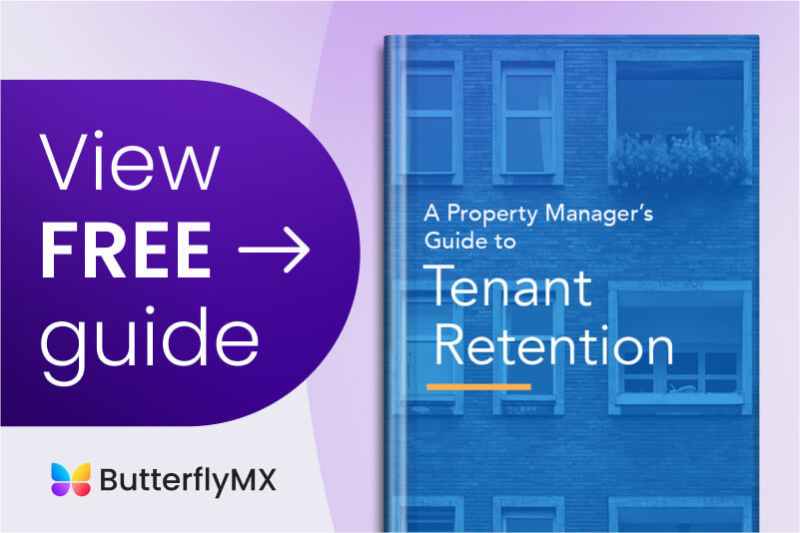Key takeaways
- A lease renewal notice informs tenants that you’re interested in keeping them at your property.
- Generally, property managers prefer to renew leases instead of finding new tenants because a unit will have to sit empty while you’re finding a new tenant.
- To encourage residents to renew their leases, you can invest in new amenities and access control upgrades and be transparent about rent increases.

As a property manager, renewing residents’ leases is one of the most important parts of your job. The right lease renewal notice could be the difference between a resident happily staying on for another year and a unit on your property sitting empty — so how can you ensure that resident sticks around?
In this post, we explain a lease renewal notice and how to write one. We also provide a lease renewal notice template that you can use! Then, we discuss whether renewing a lease or finding a new tenant is better. Finally, we give you some steps to encourage residents to renew their leases.
This post covers:
- What is a lease renewal notice?
- How to write a lease renewal notice
- Renewing leases vs. finding new tenants
- How to encourage residents to renew their leases
What is a lease renewal notice?
A lease renewal notice is a letter you can send to a tenant if you want them to continue to live on your property. You can issue a lease renewal notice whether your tenant is commercial or residential.
Finding good, reliable tenants is harder than many property managers might expect. Give your tenant a lease renewal notice promptly and be flexible during negotiations. Then, you can keep your relationships with your tenants going for years.
On the other hand, you might not be interested in continuing to allow a certain tenant to continue renewing their lease. In those cases, a notice of non-renewal of the lease is necessary.
Either way, you must inform tenants and give them enough time to prepare to stay or move out.
How much notice does a landlord have to give if not renewing the lease?
You’re legally obligated to give notice if you’re not renewing somebody’s lease. Depending on your state, you’ll have to issue your notice anywhere between 30 to 120 days before the tenant’s move-out date.
How to write a lease renewal letter
Write a lease renewal letter including the new amount of rent you’d like your tenant to pay and the length of the lease you want to renew.
But if you’d like to skip the busy work, you can also download our lease renewal notice template to start retaining your tenant.
Renewing leases vs. finding new tenants
You might wonder why you should go through the trouble of writing a lease renewal notice. For many property managers, there’s a strong economic incentive to renew a lease instead of finding a new tenant.
Consider a scenario where you lose a tenant — finding another one isn’t as easy as it sounds. You’d have to put money into marketing your empty unit. You’ll also have to host open houses and involve brokers and realtors. Finally, you’ll have to ensure that a prospective tenant is the right fit. The whole process might take months.
During all of this time, your unit has sat empty when it would have been generating income if you had only been able to retain the prior tenant.
Of course, if your current tenant isn’t treating the property well or violating the terms of their lease, it’s in your best interest to find a new tenant before things deteriorate beyond repair.
How to encourage residents to renew their leases
If you’ve decided that retaining your existing residence benefits you more than finding a new tenant, you can do a few things to convince residents to stay.
A few things you can do to encourage residents to sign renewal lease agreements are:
- Investing in new amenities
- Upgrading your access control system
- Being transparent about rent increases
1. Invest in new amenities
Compared to a few years ago, residents spend more time working from home. As a result, they value the amenities included on the property more.
Many properties are installing new, enticing amenities to be competitive in today’s new rental market and make themselves more attractive to remote workers.
Examples of amenities include:
- Coworking spaces. Adding a coworking space is the ultimate way to ensure remote workers are interested in your property.
- Rooftop gardens. Green spaces that let residents relax, enjoy the outdoors, and reconnect with nature.
- Dog runs. Market your property to pet owners by adding a dog run. If your property doesn’t allow animals, consider changing this to expand your pool of potential residents and retain residents looking to get a pet.
2. Upgrading your access control system
Access control is quickly becoming one of the modern resident’s top priorities. Whether you’re talking about online deliveries or food orders being dropped off, a seamless access control experience will ensure that a resident is happy with your property.
By installing a modern, smartphone-based video intercom system, you can simplify your residents’ lives with features like remote unlocking and Visitor Passes they can text to guests. This will increase their incentive to renew their leases and make their decision to stay simple.
Discover five automation systems tenants want:
3. Being transparent about rent increases
Even if residents are fans of your property, they might be discouraged from continuing to live there if the rent increases too much.
If you invest in a new amenity or access product, you can point to the new features your residents will receive as proof that their money is being well spent—and prevent a non-renewal of your lease.








